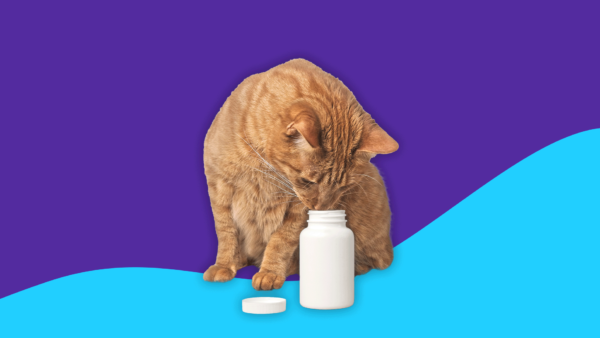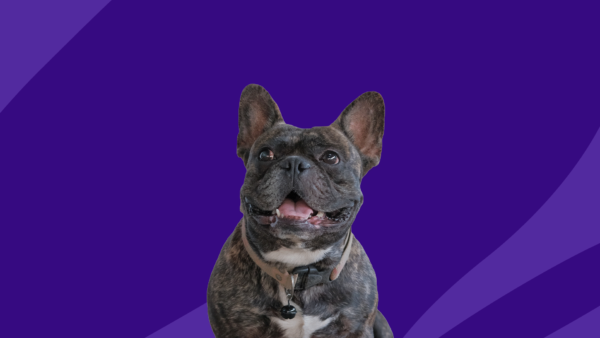When you think about keeping your four-legged friends safe in the summer, the first things that usually come to mind are preventing overheating and heat stroke, protecting dog paw pads from hot pavement, and not leaving them in a hot car. But did you know that dogs can get sunburns too? Just like humans, dogs need protection from the sun’s harmful UVA and UVB rays.
Can dogs get sunburn?
Any pet that spends more than five to 10 minutes outside daily can get a sunburn. Dogs with white or light-colored coats, thin coats, or hairless breeds are susceptible. Other factors that can make a dog more likely to burn include:
- Lightly pigmented noses and eyelids
- Illnesses or genetic problems that cause hair loss or coat thinning, such as flea infestation, or bacterial or fungal infections
- Chronic skin conditions, such as atopic dermatitis
- Areas that have been clipped or shaved for surgery
- Areas of scar tissue
- Auto-immune diseases (sun exposure could cause worsening of existing conditions)
- Certain medications, such as doxycycline, that can make a dog more sun sensitive
Dogs are most vulnerable to sun damage on the face (especially around the mouth, nose, and eyelids), ears (especially the tips), belly, groin area, inside of legs, and the tail (especially the tip).
Some breeds of dogs, such as doodles and poodles, do better with a shorter trim for the summer. But for most dogs, shaving makes them more vulnerable to the heat. Their coat helps keep them cooler and protects them from sun exposure. Shaved skin may be extra sun sensitive as it has had less exposure previously. In other words, check with your vet before shaving your dog.
Are some dogs more susceptible to sunburn?
Yes, some dog breeds are at greater risk of sunburn. Breeds that pink up in the sun include:
- American hairless terrier
- Australian sheepdogs
- Beagles
- Boxer
- Bulldogs (especially white ones)
- Chinese crested
- Collies
- Dalmatians
- Dogo argentino
- Golden retrievers
- Greyhound
- Yellow Labrador retrievers
- Mexican hairless dog
- Pit bull
- Weimaraner
- Whippets
Symptoms of dog sunburn
When you’re spending time out in the sun with your four-legged friend, it’s important to keep an eye on them to avoid sunburn. Signs that a dog may have a sunburn include:
- Pink, red, and/or tender skin (may get worse over a few days)
- Skin that is warm to the touch
- Dry, cracked, and/or flaky skin
- Curling at the ears
- Frequently itching, biting, or scratching in tender areas
- Whimper, shrink away, or act in pain when petted or touched
- Blistering or scaling of the skin (if you notice pus, that is a sign of infection that needs immediate medical attention)
- Slight fever (in more severe cases)
- Lethargy (in more severe cases)
Sunburn or repeated UV exposure could lead to skin cancer, such as squamous cell carcinoma and malignant melanoma. “Some breeds are more predisposed [to skin cancer], like pit bulls or pit bull-related dogs like bulldogs,” says Héctor Pérez, DVM, a clinical and research veterinarian in Puerto Rico. “I see that here very, very frequently. We do surgery on skin cancer on bullies and pit-related dogs at least two to three [times] a month.”
Just as you would for yourself, check your dog every few weeks, and bring them to the vet if you see signs such as red spots, lumps that look like warts, flakiness on the skin, or inflammation. These signs don’t automatically mean cancer, but they are worth getting checked.
RELATED: Protect your pup this summer: Learn the signs of heat exhaustion in dogs
Do dogs need sunscreen?
Dogs do need sunscreen—but not just any sunscreen. The safest option for your pet is sunscreen labeled explicitly for dogs. It should be at least SPF 30. Use lotion or cream formulations so that your pet doesn’t inhale or get aerosol spray in their eyes. Some recommended dog-safe sunscreens available on Amazon or Chewy include:
- Warren London Dog Sunscreen Spray
- Lucky Pup Sunscreen Dog Balm
- Handy Hound SnoutScreen
- My Dog Nose It! Sun Protection Balm
- My Dog Nose It! Coat & Body Spray
- Epi-Pet Sun Protector Spray
- Emmy’s Best Pet Products Dog Sun Skin Protector Spray
- Doggles Sunscreen
- Virbac Pet Guard Gel with Sunscreen
- Dr. Schmedley’s Sol Screen with SPF 30
- Petkin SPF 15 Doggy Sunstick
Human sunscreen is not advised for dogs because it may contain ingredients that are toxic to dogs. If doggy sunscreen is not an option, products labeled for human babies may be okay if they don’t contain zinc oxide or other zinc products found in many sunblocks, para-aminobenzoic acid (PABA), or salicylates.
Fragrance-free and water-resistant is also best. Just be sure to consult with your veterinarian before using any product not specifically labeled for dogs. It’s important to note that dog safe doesn’t mean cat (or other pets) safe. Don’t use sunscreen on your non-canine pets, including ones labeled for dogs, unless they specify they are safe for that animal and/or you have talked to your vet.
How to apply pet sunscreen
Before using sunscreen for dogs for the first time, try a small amount on a small area of skin to check for reactions. It’s best to do this at least 24 hours before fully applying it if possible.
“Similar to humans, sunscreen should be applied at least 15 to 20 minutes before heading outside,” says Jyl Rubin, DVM, a veterinarian with Dr. Jyl’s Mobile Vet Connection and Veterinary Hospital in Orangevale, California. “Apply sunscreen every one to three hours when outdoors for longer periods of time. If your dog is a swimmer (or likes to roll around in puddles, or chase hose water), dry them off and reapply afterward.”
Being careful not to get any in your pup’s eyes, apply the sunscreen, focusing on the nose, ears, belly, and groin area, and anywhere else your dog’s skin is exposed.
Dogs with lighter-colored, shorter, or thinner fur will need more sunscreen than dogs with thick, dark coats. If using a spray sunscreen, it’s best not to spray it directly on your dog as it could get in their eyes or they may inhale it. Instead, spray it on your hands first, then apply it to your dog using your hands. Once your dog’s sunscreen is applied, watch your dog closely and prevent them from licking it.
Dog sunscreen alternatives
Even with sunscreen, a dog is not fully protected from the sun. Using additional sun-protection measures keeps your dog safer and more comfortable. These steps are similar to humans. For example, stay out of the sun during the hottest part of the day. For dogs most vulnerable to sun damage, Dr. Pérez recommends keeping them indoors during the day, especially peak hours—from 10:00 a.m. to 4:00 p.m.—and letting them get their outdoor exercise in at night.
When outside, provide lots of shade for your dog and access to drinking water. If your dog is extra sensitive, you can purchase a sun shirt with built-in UV protection, but make sure he doesn’t get overheated when wearing it.
“If you’re going to walk the dog a lot, you should probably clothe the dog,” says Dr. Pérez. “It’s one of the few times I’m for clothing a dog, just to protect it from the sun.” Don’t forget booties to protect your feet from hot surfaces. If it’s too hot for your feet, it’s too hot for theirs.
And it’s important to note that sun protection isn’t just for the summer. “When it’s snowing, there’s a lot of reflection of the snow from the sun if it’s a sunny day, and that reflection can hit the belly,” Dr. Pérez says.
Dog sunburn treatment
If, despite your best efforts, Fido ends up getting burned, there are things you can do to help him feel better. First and foremost, make sure to keep your dog hydrated while recovering from a sunburn. Offer them small amounts of ice chips, and provide them with plenty of fresh, clean water. Watch for signs of dehydration.
For mild sunburns, you can apply cold compresses and apply dog-specific aloe vera gel topically to the area. If a burn is worse than slightly pink skin with no pain, your dog should be seen by a veterinarian.
If your dog is experiencing discomfort or pain, a veterinarian can address the sunburn with:
- Pain medication
- Antibiotics
- Topical creams
- Wound cleansing
- Additional therapy as needed
Keep your dog out of the sun until the burn is completely healed. If your dog’s skin is dry after a burn, virgin coconut oil or shea butter can be a good option for moisturizing.
Signs that sunburn is an emergency and your dog needs immediate medical care include:
- Skin turns dark red or purple
- There are blisters with pus
- Your dog is dehydrated (watch especially for your dog becoming weak or lethargic)
- Your dog has stopped eating and/or drinking
- Your dog is in a lot of pain (crying, whining, yelping, having difficulty moving without pain)
If any of these occur, or you think your dog needs help, take them to the vet immediately. The sooner the vet sees them, the easier it will be for them to fully recover.











